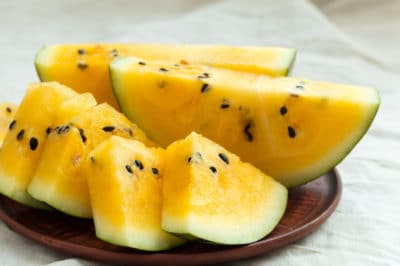True Lovers of Heat
Regardless of the variety you are growing, all yellow watermelons are heat-lovers that perform best when outdoor conditions are consistently warm. Depending on where you live, your season of prolonged warm temperatures might start as early as March or in late May to early June.
The more north you reside, the later you can expect to safely plant your yellow watermelon seeds or transplants. These are warm-season annuals very sensitive to frosty, cold temperatures. In fact, Florida is the only state where the year-round warm climate makes it possible to grow watermelons all year.
Prime Temperatures for Germination & Planting
Since outdoor conditions that are too cold impede the watermelon plant’s growth and seeds can fail to germinate, it’s important to plant when temperatures are at their prime.
- The best temperatures for germination are between 70°F to 95°F (21.1°C to 35°C). Germination occurs in a couple of days, when seeds are planted in 95°F (35°C) and can take a week, when planted in 70°F (21.1°C).
- Watermelons thrive when planted and grown with temperatures ranging between 70°F and 85°F (21.1°C and 29.4°C), but still handle temperatures of 90°F (32.2°C).
How to Get a Jump on the Season
If you live in a cooler region where the growing season is shorter, or you just want to get a head start on growing your yellow watermelon plants, there are steps you can take to get things off to a good start.
- In late winter or early spring, cover the garden area with black plastic, being sure to secure the ends in place. This not only organically kills any unwanted vegetation, but the black plastic helps the soil retain warmth.
- You can also mulch around the watermelon plants with black, plastic mulch, which helps retain heat in the soil.
- Placing fabric row covers over young plants also retains warmth in the soil. However, once the plants start blooming you have to remove the covers for proper pollination of the flowers. Keeping the row covers in place can impede pollination, which reduces the watermelon crop.
- Start seeds indoors in peat pots two to four weeks before the last frost in your area, and plant out in the garden two weeks after the last frost. Like all melons, watermelons have sensitive roots and you can plant the entire peat pot in the garden without disturbing the root system.
Expert Tip: Plant your yellow watermelon seeds ½ inch deep.
Selecting the Right Yellow Watermelon Variety
When selecting a yellow watermelon variety to grow, you’ll want to pay attention to the seed packet and how many days from planting until harvesting. If you live in an area with a shorter season, you’ll want to select a cultivar that doesn’t take as long to ripen.
However, if you live in a location with a prolonged season on warmth, you can grow any yellow watermelon variety because it will have time to ripen before cold weather arrives. Some yellow watermelon varieties, including those with yellowish outer skin and their characteristics include:
- ‘Yellow Doll’ is a hybrid producing 3- to 7-pound, yellow-fleshed melons green striped skin. Semi-compact vines mature in 68 to 80 days.
- ‘Yellow Alice’ is a Korean hybrid producing small, round fruits with yellow-flesh. Matures in 55 to 60 days.
- ‘Golden Midget’ produces 3-pound fruits, with golden yellow skin and pink inner flesh. Matures in around 70 days.
- ‘Golden Crown’ produces 5- to 7-pound, red-fleshed fruits with golden yellow skin and is disease-resistant. Matures in 78 days.
- ‘Desert King’ produces 20- to 30-pound, yellow-fleshed fruit and takes 85 to 100 days to mature.
- ‘Sweet Siberian’ produces 8- to 10-pound, yellow-fleshed fruit, with light green skin. Matures in around 80 to 85 days.
Expert Tip: Yellow watermelon varieties producing smaller fruits are suitable for growing up a trellis. Just make sure the trellis is sturdy enough to hold the developing fruits. You can support the melons with pantyhose, placing them around the watermelons and creating a sling while they are still small.
